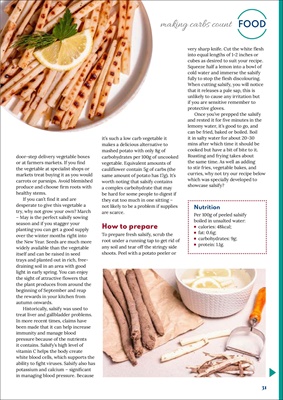
31
FOOD
Nutrition
Per 100g of peeled salsify
boiled in unsalted water:
calories: 48kcal;
fat: 0.6g;
carbohydrates: 9g;
protein: 1.1g.
making carbs count
door-step delivery vegetable boxes
or at farmers markets. If you find
the vegetable at specialist shops or
markets treat buying it as you would
carrots or parsnips. Avoid blemished
produce and choose firm roots with
healthy stems.
If you can't find it and are
desperate to give this vegetable a
try, why not grow your own? March
- May is the perfect salsify sowing
season and if you stagger your
planting you can get a good supply
over the winter months right into
the New Year. Seeds are much more
widely available than the vegetable
itself and can be raised in seed
trays and planted out in rich, freedraining
soil in an area with good
light in early spring. You can enjoy
the sight of attractive flowers that
the plant produces from around the
beginning of September and reap
the rewards in your kitchen from
autumn onwards.
Historically, salsify was used to
treat liver and gallbladder problems.
In more recent times, claims have
been made that it can help increase
immunity and manage blood
pressure because of the nutrients
it contains. Salsify's high level of
vitamin C helps the body create
white blood cells, which supports the
ability to fight viruses. Salsify also has
potassium and calcium - significant
in managing blood pressure. Because
it's such a low carb vegetable it
makes a delicious alternative to
mashed potato with only 8g of
carbohydrates per 100g of uncooked
vegetable. Equivalent amounts of
cauliflower contain 5g of carbs (the
same amount of potato has 17g). It's
worth noting that salsify contains
a complex carbohydrate that may
be hard for some people to digest if
they eat too much in one sitting -
not likely to be a problem if supplies
are scarce.
How to prepare
To prepare fresh salsify, scrub the
root under a running tap to get rid of
any soil and tear off the stringy side
shoots. Peel with a potato peeler or
very sharp knife. Cut the white flesh
into equal lengths of 1-2 inches or
cubes as desired to suit your recipe.
Squeeze half a lemon into a bowl of
cold water and immerse the salsify
fully to stop the flesh discolouring.
When cutting salsify, you will notice
that it releases a pale sap, this is
unlikely to cause any irritation but
if you are sensitive remember to
protective gloves.
Once you've prepped the salsify
and rested it for five minutes in the
lemony water, it's good to go, and
can be fried, baked or boiled. Boil
it in salty water for about 20-30
mins after which time it should be
cooked but have a bit of bite to it.
Roasting and frying takes about
the same time. As well as adding
to stir fries, vegetable bakes, and
curries, why not try our recipe below
which was specially developed to
showcase salsify?